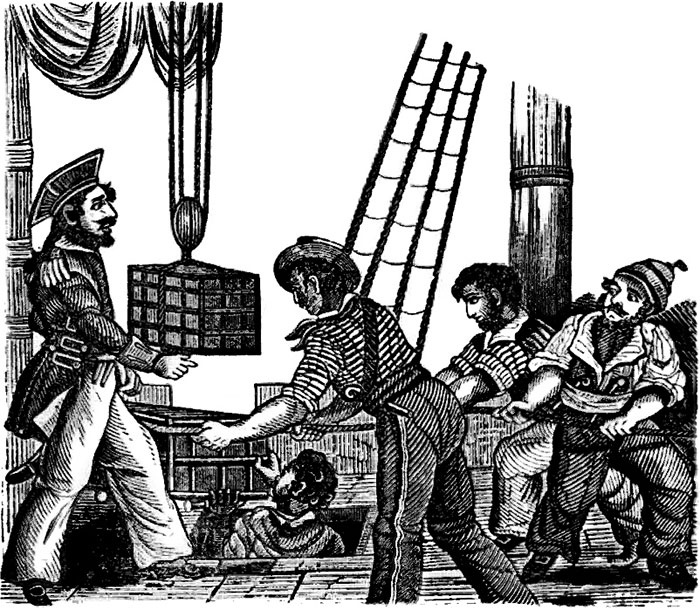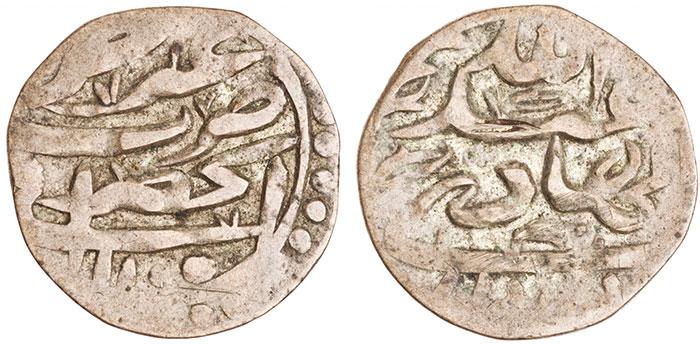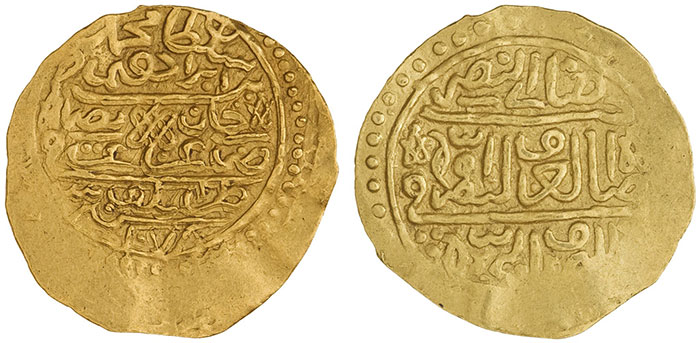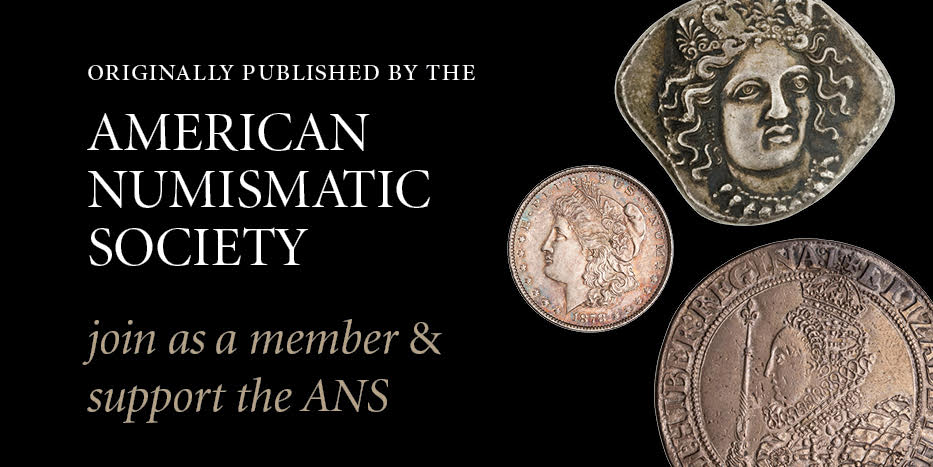
By Oliver Hoover for American Numismatic Society (ANS) ……
On April 1, 2021, the Associated Press ran a story about a handful of small silver coins from 17th-century Yemen found by metal detectorists in New England and the theory advanced by Jim Bailey that these coins actually represent pirate plunder. In fact, he argues that they are the remains of plunder taken by Henry Every (also written as “Avery”) in one of the most famous pirate actions of the 17th century—the taking of the Mughal ship Ganj-i-Sawai (“Exceeding Treasure”) while returning from Mecca to Surat in 1695.
The story was quickly seized upon and embroidered by online news outlets over the week that followed. This is perhaps not overly surprising. The readiness with which the Associated Press has picked it up and other news outlets have run with it is clear testimony to the story’s popular exciting qualities. However, as with most astounding discoveries and anything even remotely endorsed by Capt. Jack Sparrow, it is usually a good policy first to sit down, take a deep breath, and then take stock of the actual evidence to determine whether it can really support the weight of the claims piled on top of it.

But first, a little background that seems to have been missed.
Although the Associated Press piece reports that Bailey “found the first intact 17th-century Arabian coin in a meadow in Middletown [in 2014],” he was actually preceded by the hosts of the National Geographic Channel’s Diggers, who discovered one in 2013 and sought the assistance of the ANS in identifying it. The identity of the coin was subsequently published and it appeared in the Diggers episode “Mystery Coin,” which aired on March 4, 2014. Bailey’s find coin, as well as several others, were published in the August 2017 issue of the Colonial Newsletter, along with his theory associating them with Every and the plunder of the Ganj-i-Sawai. Inexplicably, the Colonial Newsletter as the original publication is not mentioned in the Associated Press item, but is bizarrely misidentified in many of the secondary media reports as “the American Numismatic Society’s research journal” or the nonexistent “Journal of the American Numismatic Society”, etc.). The American Numismatic Society’s research journal is actually the American Journal of Numismatics (AJN) but Bailey has never published there.
Although the case for associating finds of coins in New England with Every and the Ganj-i-Sawai can be read in full online thanks to the availability of the full run of the Colonial Newsletter on the Newman Numismatic Portal, his argument rests primarily on three main pieces of evidence:
- In 1695, when the Ganj-i-Sawai was seized by Every and his piratical colleagues after departing from the Yemeni port of al-Makha (Mocha), the ship is known to have contained thousands of silver coins.
- After political and economic fallout from the plunder of the Ganj-i-Sawai caused King William III to issue a proclamation calling for the capture of the pirates responsible, some (Bailey suggests 72) of Every’s associates made their way to the American colonies (especially Rhode Island and Carolina) with their loot in the hope of evading the long arm of the law.
- Of four Yemeni coins found in Rhode Island and Massachusetts that can be dated with any accuracy, none post-date the capture of the Ganj-i-Sawai.
The first two facts indicate how coins plundered from the Ganj-i-Sawai could have come to New England, but do not prove that they did, or that if they did, the coins in question must have been Yemeni khamsiyat (corrupted in contemporary 17th-century English as comassees). The case is very problematic because it begins with the assumption that the coins had to have come from the Mughal ship and pays little serious attention to the possibility that they could have been brought back by American merchants involved in the East African slave trade, the Yemen coffee trade, or by pirates other than Every and his accomplices.
Bailey argues in the Associated Press piece that “there’s no evidence that American colonists… traveled to anywhere in the Middle East to trade until decades later” (i.e., after the plunder of the Ganj-i-Sawai) and yet in his Colonial Newsletter article the “overlapping business interests of piracy and the East African slave trade” (p. 4607) are noted with respect to the New York ships Margaret and Nassau in 1699 (only four years after the Ganj-i-Sawai incident) and Every and his colleagues are suspected to have come to Newport, Rhode Island, under the guise of East African slave dealers (pp. 4601–4605)—an odd thing to do if this trade did not yet really exist.
But even if we set all of this aside, whatever contextual evidence there may be for any of the found Yemeni coins cannot tell us precisely when they arrived in New England or in whose pockets.

As much of the silver on the Ganj-i-Sawai was said to have been that of “Turkish merchants”, one might have expected it to have included many Ottoman kuruşlar—large silver coins introduced in 1688 that were roughly equivalent to European thalers—that would have been far more appropriate for large-scale trade with Mughal India than low-denomination comassees. And even if large quantities of khamsiyat were taken by the pirates, as Bailey himself notes, they were at pains right away to convert as many of the silver coins as possible into more easily transportable gold. John Dann, one of Every’s accomplices, was later arrested in Ireland, given away by the large numbers of gold chequins (perhaps Ottoman sultanis, Safavid Persian ashrafis, or Mughal mohurs) sewn into the lining of his coat! There also may have been some conversion into Spanish silver, judging from the bags of reales that another of the pirates had in his possession when apprehended in Ireland.

The third fact presented by Bailey is of extremely dubious value, not only because the sample size is much too small to be meaningful but because it may not be truly factual.
With one exception, all of the khamsiyat listed by Bailey are issues of the Qasimid imam Muhammad III ibn Ahmad (1686–1717). When dates are not visible (or present), the coins of this Yemeni ruler can be dated to three chronological periods based on his titulature. Issues naming him as “an-Nasir” were struck in the period 1687–1693, those naming him as “al-Hadi” in 1693–1697, and those naming him as “al-Mahdi” in 1697-1718. Therefore, if all the Yemeni coins found in New England were struck prior to the plunder of the Ganj-i-Sawai, there should only be issues in the name of “al-Nasir” and “al-Hadi”. Nevertheless, Bailey includes two coins of “al-Mahdi” (one of which is his discovery coin) in his list of New England finds (p. 4582, Table 2). These are almost certainly errors for “al-Hadi”, which is very clear on the discovery coin (p. 4582, Table 2, no. 1) but illegible on the second specimen (p. 4582, Table 2, no. 7). However, the close similarity of the latter’s reverse legend to a third coin, clearly struck in the name of “al-Hadi” (p. 4582, Table 2, no. 3), suggests that Bailey’s No. 7 is also an “al-Hadi” issue.

Bailey’s discovery coin is critically important for the question of potential connection to Henry Every and the Ganj-i-Sawai because it is the only coin recovered with a visible date. In his article, this date is interpreted as AD 1693, which fell in January–August AH 1104 and September-December AH 1105, but he does not indicate which Hijri year was actually read on the coin. The year AH 1104 is normally written ١١٠٤ in Arabic while 1105 is written ١١٠٥ (see the ANS specimen above for this date and note the difference between the final numeral there and that on Bailey’s coin). Neither of these forms seems to closely match the numbers that appear on the coin. Upon close inspection, the date on Bailey’s coin appears to read ١١٠٨ or AH 1108, the Hijri year that extended from July 31, AD 1696 to June 20, AD 1697 (I am grateful to Dr. Jere Bacharach for confirming the AH 1108 reading of the date). If the date is correctly read here as AH 1108, the coin was struck too late to have been carried off from the Ganj-i-Sawai. Every and his pirates captured and plundered the Mughal ship on September 7, 1695 (i.e., at the beginning of AH 1107), whereas if the coin bears an AH 1108 date, as seems to be the case, at the very earliest it could have been struck only shortly before the proclamation of August 8, 1696, that began the manhunt for Every and his associates. It should go without saying that an AH 1108 date is an insurmountable problem for Bailey’s popular theory.
The preceding discussion seems to scuttle the idea of closely pinning 17th-century Yemeni coins found in New England on the fallout from one of the most famous acts of piracy of the period. The stardom that Bailey has attached to Yemeni coins with New England find contexts actually obscures the real importance of the coins, which should be linked to other reported finds of Mughal and related Islamic coins in North America. They all serve to underline the fact that the early American colonies did not exist in a vacuum but rather belonged to global networks of trade and cultural interaction (and piracy), and that enterprising individuals could and did profit from these networks if they were willing to undertake the great dangers of sailing half a world away.





